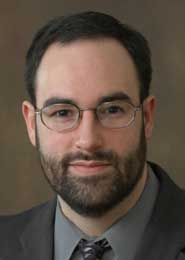Professor Michael S. Strano
The National Science Foundation article The Tiniest Test Kits: A Medical Future for Carbon Nanotubes? said
“Imagine if diabetics could read blood-glucose levels by reading a watch. Or if researchers could monitor hormone levels, in real-time, in their subjects. What sounds like science fiction today could be reality soon, thanks to carbon nanotubes.Just after Christmas 1959, physicist Richard Feynman delivered a now-famous talk — titled ‘There’s Plenty of Room at the Bottom’ — to a bemused audience at the California Institute of Technology. Could it be possible, he proposed, for scientists to assemble new materials at the level of single atoms and molecules, where there are ‘new kinds of forces and new kinds of possibilities, new kinds of effects’?
Tooling with the tiny, Feynman believed, could mean something very big for science. Recent research developments make clear how right he was.
Michael Strano, a professor of chemical and biological engineering at the University of Illinois, is working on the design of a new class of medical sensors. With support from the National Science Foundation (NSF)’s Directorate for Engineering, Strano and his colleagues have created tiny, implantable devices that could one day allow diabetics to continuously monitor glucose levels without drawing a drop of blood.”
Michael S. Strano, Ph.D. is Assistant Professor, Department of Chemical and Biomolecular Engineering, University of Illinois at Urbana/Champaign. He earned his B.S. (summa cum laude) in Chemical Engineering at Polytechnic University; Brooklyn, NY in 1997 and his Ph.D. (summa cum laude) in Chemical Engineering at University of Delaware, Newark, DE in 2002.
His patents include Method for separating single-wall carbon nanotubes and compositions thereof (this patent was shared with Nobel Laureate Richard E. Smalley), Nanoporous carbon catalytic membranes and method for making the same, and Supported mesoporous carbon ultrafiltration membrane and process for making the same.
Michael authored Nanocomposites: Polymer-wrapped nanotubes and coauthored Top-down fabrication of semiconductor nanowires with alternating structures along their longitudinal and transverse axes, Reversible Control of Carbon Nanotube Aggregation for a Glucose Affinity Sensor, Two-photon photoluminescence and exciton binding energies in single-walled carbon nanotubes, Charge Transfer from Metallic Single-Walled Carbon Nanotube Sensor Arrays, and Pentacene-carbon nanotubes: semiconducting assemblies for thin-film transistor applications. Read the full list of his publications!
His awards include Presidential Early Career Award for Scientists and Engineers (PECASE) (2006), Coblentz Award for Molecular Spectroscopy (2006), National Science Foundation Career Award (2005), “Most significant advances of 2003” – Chemical & Engineering News (2003), North American Catalysis Society Kokes Award (2001), and AIChE Division of Catalysis and Reaction Engineering Award (2000). He is an Editorial Board Member of the Journal of Experimental Biology and Medicine, a Panel Reviewer for NCI Nanotechnology Platforms, and an Industrial Consultant for Intel.
